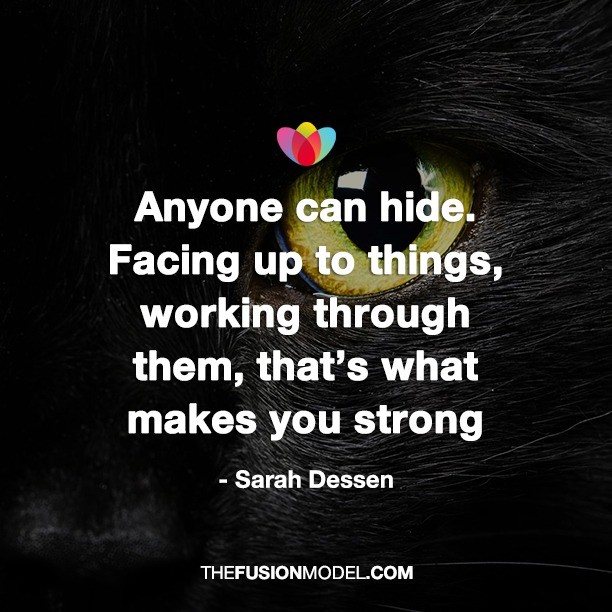[Tweet “‘You never know how strong you are until being strong is your only choice’ – Bob Marley”]
Some professional experiences are so profound they have the power to shift perception in a moment. Our clients are so often our teachers.
Many years ago, as a trainee Rogerian counsellor, I came to understand self harm at a much deeper level when I met Sam.
He had been living rough for several years, pitching a tent in local woodland or sleeping in shop doorways from time to time. His adult life had been tough. So had his childhood. I can see him now, grinning at me across the Formica table that separated us.
Sam didn’t have many teeth left. They fell out, or were punched out, over a lifetime of struggle.
Glancing to one side in the glass partitioned cubicle, there were other inmates in conversation with their legal advisers and social workers. Like many of the men I encountered while working in this category A prison, Sam was a victim. He had a traumatic story that went back to when he was a small boy.
Neglected by his mother, abused by his father, Sam had opted to leave home as early as possible and took to the streets. A life of petty crime followed.
But my heart went out to him when he rolled up his sleeve to show me the many cuts that criss-crossed his arms. Mostly they were healed with raised, bluish, keloid scars but, worryingly, some marks looked fresher, brighter, redder than the others.
‘Do you want to say something about the cutting Sam?’ I asked, and listened attentively as he tried to explain why he did it, how it felt and the purpose it served.
The experience, for me, by the end of the session, was so intense that, when he left the cubicle and I waited for the patrolling officer to open up my door, I hurriedly wrote down all the thoughts and feelings which came to me in that moment. Those words I would later construct into a piece of poetry to try to capture, as best I could, the essence of what Sam had tried so hard to convey to me.
Self harm: the latest figures
Getting help for self harm is in the news again. It’s been highlighted as a growing problem in our schools.
The number of pupils who cut burn or hurt themselves in another way has been rising sharply in recent years.NHS figures show there were 28,730 admissions in England for self-harm among 10 to 19 year olds in the year to March 2014 compared with 22,978 the year before. However this is likely to be just the tip of the iceberg as many more youngsters who harm themselves do not end up in hospital. Many self-harmers who repeatedly harm themselves cover their scars to avoid attention.
Care minister Norman Lamb said: “Self-harm is a sign of serious emotional distress and it is crucial that young people get the help they need.” Mr Lamb added that a team of specialists is currently examining how to improve care in schools to offer help for self harm, and £150 million is being invested over the next five years to deal with self-harm and related issues.
But why is self harm on the increase and why does it affect younger and younger children?
Looking at the issue through the ‘SAFE SPACE’ lens can be a very helpful starting point.
Self harm and SAFE SPACE
The SAFE SPACE ‘recipe’ for emotional well-being covers Security, Attention, Fun family and friendship, Emotional intimacy, Status, Privacy, Achievement, Control and Engagement. When these universal human needs are being met, we feel our life is worth living. We feel positive, motivated and engaged with a world which has meaning and purpose for us.
And we have a kind of internal SATNAV which is always trying to push us towards getting these needs met, with a range of ‘towards’ or ‘away from’ instincts and emotions, some of which can very uncomfortable.
Along the way, we can develop complex mechanisms for ‘affect regulation’ or emotional management, as we try to keep emotions within a comfortable range. Drink, drugs and addictions become the props and crutches we might use as adults to get us through.
But, for children, so much of their life is outside their control. As they try to construct their personal identity, outside pressures, stresses and strains can materialise in behaviours which might begin as a coping mechanism but can soon develop into a pattern, a conditioned response….. an addiction.
At first, cutting or self harm can give an illusion of getting needs met, just as with other addictive behaviours:
• As a way of avoiding uncomfortable emotion and staying Safe.
• As a way of communicating distress and drawing Attention.
• As a covert act in Private
• As a way of exercising Control.
If, like me, you have been in the presence of someone who is cutting, you would notice a trance-like Engagement as the cutter becomes totally absorbed in the act. The dopamine rush offers its own reward. So, it seems clear that self harm is best viewed and treated as an addiction, as should anorexia and bulimia.
For young people who get caught up in a ‘peer culture’ of self harm, the act itself can become a bonding experience and also tick the boxes for Emotional intimacy, Friendship, Status and Achievement.
Helping Sam
Sam’s self harm began in childhood too.
When we had our encounter all those years ago, I offered him everything I had in my counselling toolbox at that time. I listened respectfully and without judgement. I tried as hard as I could, with empathy, to see through his eyes, to feel some of his immense pain.
To my former self, I would now say ‘You did what you could with what you had……..but it was not enough.’
My professional evolution to therapeutic coach has seen the acquisition of many more skills and tools along the way, which would have been very helpful for Sam:
• Normalisation of the mechanism of distress through psycho education
• Resolution of trauma with imaginal exposure
• Behavioural pattern breaking with The STOP System
• Dealing with cognitive distortions
• Establishing helpful behaviours through positive mental rehearsal
• Restoration of hope and motivation with metaphor and therapeutic story
• Super future pacing
• Holistic life coaching
• Goal setting
There is so much more I could do now but, back then, with enormous good will and good intentions, I listened respectfully as he told his story and wrote for him a poem that he would never actually see.
For Sam
For all the crap, for all the hurt,
I cut.
For all the tears, rejection, fears,
I cut.
For the man who was no father to me
the mother who I lost.
For all the doors slammed in my face,
I cut.
The pressure builds. Internal screams.
A thousand voices rise.
Orgasmic rush explodes in pain.
The razor is my only friend.
See my blood. I’m drenched in blame.
Can you feel the toxic shame?
Consign it to an unmarked grave,
conceal it if you must.
They call me weak. Yet I am strong
they see victim. I survive.
The look of pity in your eyes
betrays the truth, deflects the guilt.
For I am you and you are me.
The screaming of your inner child
connects us in a bond of pain.
Where do I stop and you begin?
Coagulation seals the vein




